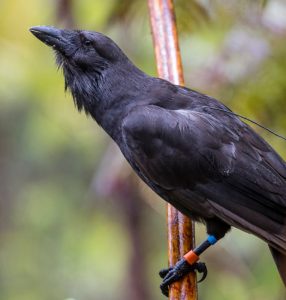
ʻAlalā
The species recovery effort, known as The ʻAlalā Project, is announcing the next steps in the recovery efforts of ʻalalā (Hawaiian crow).
Last October, in response to mortalities of released ʻalalā, including predation by ‘io (Hawaiian hawk), conservationists brought the remaining birds from the Pu‘u Maka‘ala Natural Area Reserve, on Hawaiʻi Island, back in from the wild – returning them to the conservation breeding program at the Keauhou Bird Conservation Center. Released between 2016 and 2019 and having lived in the wild for 2-3 years, these five birds gained knowledge about foraging, predator avoidance, pair bonding, and other social behaviors that could be passed on to the birds residing within the conservation breeding program and aid with future recovery efforts.
Jackie Gaudioso, a wildlife biologist with the DLNR Division of Forestry and Wildlife (DOFAW) and coordinator for the ʻAlalā Project, said, “The partners of The ʻAlalā Project will keep the momentum of Hawaiʻi Island ʻalalā release planning going, as potential release areas undergo supportive habitat management and infrastructure preparations. While self-sustaining populations of ‘alalā on Hawai‘i Island are necessary for the long-term recovery of the species, understanding ʻio behaviors and movements is crucial before we pursue future Hawaiʻi Island releases”.
As the effort to improve success of Hawaii Island reintroductions continues, the Project has begun preliminary work to explore the potential for Maui Nui to serve as an additional release site for ʻalalā. While ʻalalā were historically known to inhabit forests on Hawaiʻi Island, there is subfossil evidence that ʻalalā or a similar species once existed on Maui. Predation by ‘io has been a major challenge to Hawaii Island releases, but ‘io are not present on Maui Nui, providing an opportunity to better understand how ʻalalā can live in a forest where ‘io are not present.
Dr. Fern Duvall, the Maui Nui program manager for the DOFAW Native Ecosystems Protection and Management Program has a long history with the ‘alalā, as far back as the 1980s. “We have forests that are similar to the forest on Hawai‘i Island where ʻalalā were released. There are abundant food resources in our Maui Nui forests; abundant trees that would be suitable for nesting platforms. And we do not have the ʻio predation risk, because we don’t have ‘io here” Duvall said.
The first steps in consideration of a reintroduction of ʻalalā to Maui Nui will be a careful review and assessment of potential sites for releases, as well as outreach and discussion with conservation partners and the community to assess the feasibility of releases. In the coming months, The ʻAlalā Project will be reaching out to conservation partners and community members within Maui Nui to evaluate habitat suitability and support for future releases.
Hawaiian hawk (ʻio) research will also be conducted at the previous and at additional potential release areas on Hawaiʻi Island over the next few years to inform future Hawai‘i Island releases and to support release implementation. The research topics include species’ distribution, movements, and monitoring the behaviors of individuals.
Bryce Masuda, Conservation Program Manager of the San Diego Zoo Wildlife Alliance’s Hawai‘i Endangered Bird Conservation Program said, “We are excited to move forward with the next steps for the recovery of ʻalalā together with the community. As we have seen with the recovery of other endangered species, successful programs must problem solve – incorporating new strategies and applying science to achieve thriving populations of wildlife.”